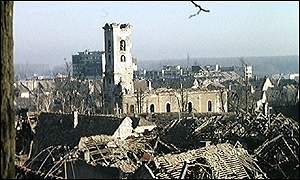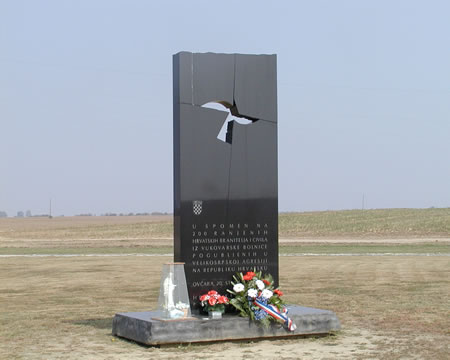Croatia Revisited
For the Week of May 19, 2003
Earlier this month it was my pleasure to give a week of lectures at the Evangelical Theological Seminary in Osijek, Croatia. I had been there two years ago, so it was a special delight to renew some friendships with students and colleagues I had met then and to learn what the Spirit of God is doing among them.With a population of about five million people, Croatia is a small country. It is overwhelmingly Catholic (about 85%), and if you look at a map you can see that it is somewhat fascinating as the eastern most bastion of Western, Latin Catholicism. If you travel east or south you encounter the Orthodox, Muslim or (former) atheist. The mainly Serbian Orthodox number about 12%, Muslims 1.2%, and Protestants a minuscule 0.4%.
Founded in 1972, the seminary is likewise small. The 70 students come from 10 countries. My class of 25 first and second year students was typical. They were almost all Baptist and Pentecostal, and while most of them were from Croatia, I also had students from Albania, Bulgaria, Romania, Ukraine and Belorussia.
Before the breakup of Yugoslavia in 1991, what is now Croatia enjoyed a well-deserved reputation for its gorgeous Adriatic coast, where Europeans flocked to the beaches every year. Of special note is the seacoast town of Split where you can still see the massive palace of the Roman emperor Diocletian (245-313). It was Diocletian who ordered the last and harshest persecutions against Christians. The early church historian Eusebius (265-339) tells us that under Diocletian churches were razed, the Scriptures confiscated and burned, meetings of Christians abolished, the clergy arrested and even the laity persecuted.
But that pristine, tourist image of Croatia vanished with the war, which in some important ways had its beginnings in Vukovar, just a twenty minute drive from the seminary. Vukovar used to be a town of about 85,000 people on the border with Serbia. The Danube River passes through town. Before the war its population was about 43% Croat and 37% Serb, an ethnic mix that was not too unusual. But that was then, before the war.
 |
|
Vukovar in June 1991. BBC copyright 1991 |
Vukovar also provided one of the best documented and thoroughly investigated cases of unimaginable war crimes. Even today you can find web page photos where soldiers proudly display the decapitated heads of the enemy. Of special note was the case of the Vukovar hospital. On November 20, 1991 the Serbs went to the hospital and loaded up upwards of 300 patients, medical staff and civilians. They drove these Croats outside of town a few kilometers to Ovcara, where they murdered them and dumped them into a mass grave.1
 |
| Ovcara mass grave memorial. Original photographer unknown. Photo obtained from Google, originally from www.kneginec.hr/Vijesti/vukovar.htm (at the time of writing, this website no longer accepts external connections) |
As I stood in the hot sun on that mass grave in a field in Ovcara, just twenty minutes from the seminary, I felt overwhelmed. I wondered what my two seminary students who were from Vukovar remembered of all of this and what it had done to their psyches. I wondered what the bus loads of children were told who came here for field trips. Were they told, “see what these bastards did to us? Revenge will be ours some day.” Or were they told, “love your neighbor and don’t ever let something like this happen again.” I wondered what the bus loads of elderly people from the capital of Zagreb (four hours away) thought when they came here to try to make their personal peace with history.
Today, twelve years later, some people have returned to Vukovar and some buildings have been restored. But the train station is still in ruins; on my visit to Vukovar two years ago I brought home some shrapnel from this train station. It now sits on my book shelf. The town’s water tower looks like swiss cheese. Huge trees grow out of the kitchens and living rooms of what used to be houses. The kids are back in school, but there are separate schools for the Croats and the Serbs. Signs along the roads still warn of the many land mines that remain.
But if you look carefully in Vukovar you can see beautiful houses with window boxes of geraniums. You see small businesses reopening. My friend and I enjoyed a nice lunch on the Danube, with Serbia just across the river. The more I thought and reflected the more I saw the powerful and beautiful work of the Spirit in an otherwise small, war torn land.
There was Michelle, a Presbyterian missionary professor at the seminary who with a Croat friend was doing seminars in the public schools called Alternatives to Violence. She and her husband Steve have served the seminary for nine years. There was Ludmilla, whose parents sent her to Italy for five years during the war. She speaks four languages and is only sixteen. Miroslav Wolf, an evangelical theologian who now teaches at Yale, got his start here, for it was his father, a Pentecostal pastor, who founded the seminary. For a few weeks every year Miroslav comes back to teach at Osijek. There is Kosta, who studied here, then did a Masters degree in Boston, and finally returned to head up a creative ministry in his home country of Macedonia.
I was reminded in Croatia of a number of Gospel themes. That the last can be first in God’s kingdom. That children somehow model what God cares about. That the poor can be blessed and that those who mourn can find comfort. That things which look insignificant from a human perspective can actually form the beginnings of things that are important in God’s eyes. The Lord of the universe does not need the powerful, the influential or the mighty; He moves among the small and inconsequential. He chooses the weak, the lowly and the foolish, and can make something out of nothing (1 Corinthians 1:26-31). In short, the view of the world from Croatia looks different than the view from Palo Alto, and for that I am grateful.
1 See www.ess.uwe.ac.uk/comexpert/ANX/X-A.htm for the final report of the United Nations on the mass graves at Ovcara.





